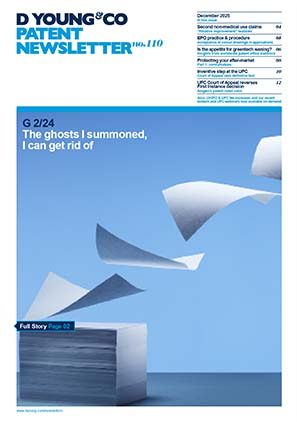G 1/23 and enablement: are commercially available products state of the art?
In this eagerly awaited European Patent Office (EPO) decision, the Enlarged Board of Appeal concluded that a product put on the market before the date of filing of a European patent application should not be excluded from the prior art for the sole reason that its composition or internal structure could not be analysed and reproduced by the skilled person before that date.
Background
This case relates to an appeal, T 438/19, filed against the decision of the Opposition Division to reject an opposition against EP2626911. In order to determine whether the subject matter of claim 1 involved an inventive step in this case, it was necessary to establish whether a commercial product (a complex polymer sold under the trade mark ENGAGE® 8400) had been made available to the public before the effective filing date of the patent, and could thus represent the closest prior art.
The referring board noted that previous case law in this area has given rise to diverging interpretations, leading to legal uncertainty regarding when commercially available products are considered state of the art. In particular, the referring board highlighted the diverging interpretations regarding the extent the commercial product must be analysable and reproducible in order to be considered state of the art.
Further details regarding the background of this case can be found in our article of 01 August 2023 “G 1/23: assessing whether commercially available products are prior art”.
The questions
The questions referred to the Enlarged Board of Appeal were as follows:
- Is a product put on the market before the date of filing of a European patent application to be excluded from the state of the art within the meaning of Article 54(2) EPC for the sole reason that its composition or internal structure could not be analysed and reproduced without undue burden by the skilled person before that date.
- If the answer to question 1 is no, is technical information about said product which was made available to the public before the filing date (for example, by publication of technical brochure, non-patent or patent literature) state of the art within the meaning of Article 54(2) EPC, irrespective of whether the composition or internal structure of the product could be analysed and reproduced without undue burden by the skilled person before that date?
- If the answer to question 1 is yes or the answer to question 2 is no, which criteria are to be applied in order to determine whether or not the composition or internal structure of the product could be analysed and reproduced without undue burden within the meaning of opinion G 1/92? In particular, is it required that the composition and internal structure of the product be fully analysable and identically reproducible?
The answers
In its decision, the Enlarged Board of Appeal answered the three questions as follows:
- No
- Yes
- Redundant in view of 1 and 2.
The Enlarged Board of Appeal’s answers taken together ultimately conclude that a product’s non-reproducibility cannot prevent that product, and technical information relating thereto, from forming part of the state of the art.
Many have noted that the Enlarged Board of Appeal’s conclusion acts to align European practice with the “on-sale bar” criteria found in USA patent practice, which dictates that if a product has been sold or is on sale, it cannot be later patented even if it is difficult to reproduce that product.
The reasoning behind the conclusion is interesting and warrants further discussion.
Correct reading of G 1/92
The questions referred to the Enlarged Board of Appeal in G 1/23 stemmed from diverging interpretations regarding a possible reproducibility criterion introduced by the earlier decision in G 1/92. In particular, this earlier decision required that the chemical composition of a product only represents the state of the art when the product can be analysed and reproduced by the skilled person. The Enlarged Board of Appeal’s decision in G 1/23 gives significant weight to establishing how this language should be interpreted.
The Enlarged Board of Appeal identified that the “reproduced” language of G 1/92 has typically been interpreted in the case law as requiring that the product is “manufacturable” from specific starting materials. Indeed, the Enlarged Board of Appeal highlighted that the statements made in G 1/92 and the questions referred in G 1/23 only “make sense” when this understanding of “reproduced” is adopted.
Taking this reading forward, the Enlarged Board of Appeal considered that two possible interpretations of G 1/92 were available:
- where the composition (and therefore the product) cannot be reproduced, the product itself is not part of the state of the art; or
- where the composition (and therefore the product) cannot be reproduced, only the composition of the product does not belong to the state of the art but the product itself and its reproducible properties do.
However, the Enlarged Board of Appeal noted that regardless of which interpretation is adopted, “manifestly absurd” results are obtained. Specifically, the Enlarged Board of Appeal concluded that every man-made material can ultimately be reduced back to a starting material that could not be made by the skilled person using the common general knowledge (for example, a chemical element). Following either of the above interpretations, such starting materials would not be reproducible and would thus not be considered state of the art. Adopting a consistent approach, if it is found that an irreproducible starting material does not form part of the state of the art, any product stemming from that starting material would also need to be eliminated from the state of the art. The Enlarged Board of Appeal highlighted that this would lead to a situation where “no material in the physical world would belong to the state of the art”.
In view of the above, the Enlarged Board of Appeal proposed that the “reproduced” language adopted in G 1/92 should be read more broadly so that it encompasses obtaining the product from the market in its readily available form. In this situation, the reproducibility requirement would be made redundant since it would be inherently fulfilled by a product existing on the market. The Enlarged Board of Appeal highlighted that this interpretation represents the normal working practice of the skilled person, who would routinely purchase products from manufacturers.
As a result, the Enlarged Board of Appeal proposed that the proper reading of G 1/92 is: “The chemical composition of a product is part of the state of the art when the product as such is available to the public and can be analysed by the skilled person, irrespective of whether or not particular reasons can be identified for analysing the composition.”
Employing this reading, the Enlarged Board of Appeal noted that “all analysable properties of the product put on the market will belong to the state of the art, i.e. they will represent technical information that the skilled person is aware of and will consider relying on when looking at technical solutions”.
Implications
The implications of the Enlarged Board of Appeal’s decision in G 1/23 will be far reaching. In its simplest sense, the decision adopts what this author considers a common sense approach in that any product placed on the market becomes prior art whether or not it is “manufacturable” because the skilled person is able to obtain a tangible copy of that product. The Enlarged Board of Appeal’s decision thus broadens the scope of the prior art and further emphasises the importance of timing when it comes to launching products and filing patent applications.
That being said, the Enlarged Board of Appeal’s decision appears to maintain that the product becomes part of the state of the art together with features of the product that can be analysed (without any need for motivation to analyse). However, little guidance is provided as to whether there are any “legal limits” as to the extent of analysis. The Enlarged Board decided not to make a determination on this. As a result, it is likely that this will form a key battle ground for cases going forward in this area.
It is also important to note that the Enlarged Board of Appeal’s decision distinguishes between the situation of novelty and inventive step when it comes to products put on the market. In particular, the board highlights that for novelty “the comparison of the invention with the state of the art does not require some particular motivation from the skilled person”.
On the other hand, for inventive step “the skilled person may have good reasons for disregarding some prior art, for example because of insufficient information attached to it. There are no formal and strict rules as to how a non-reproducible but publicly available product or any of its properties can be taken into account when inventive step is examined”. As a result, in the context of inventive step, the Enlarged Board of Appeal’s decision appears to suggest that whether a product on the market can be considered the closest prior art and whether modifications to that product are obvious, will be highly dependent on the facts of a given case.
In view of the possible complexity regarding the implementation of the G 1/23 decision, we will be keeping a close eye on future decisions in this area.
Case details at a glance
Decision level: Enlarged Board of Appeal
Parties: Borealis GmbH (appellant) v Mitsui Chemicals Inc and Mitsui (respondents) Chemicals ICT Materia Inc
Citation: G 1/23
Date: 02 July 2025
Decision (PDF): dycip.com/epo-eboa-g123

